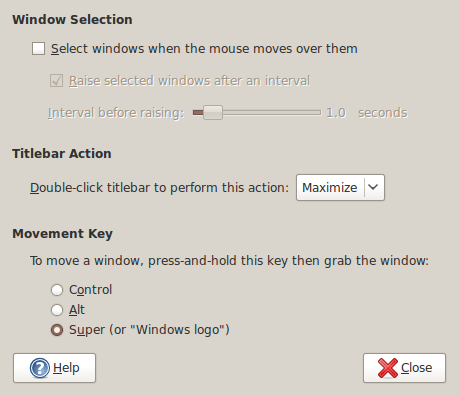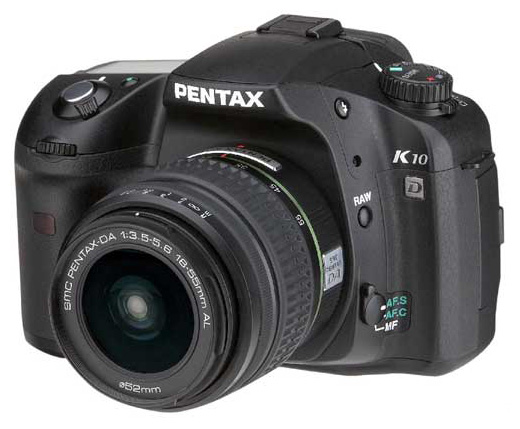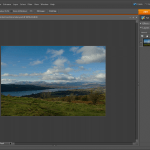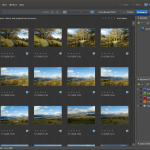On Photoshop Elements 7
10th November 2008In recent days, I have been playing around with Photoshop Elements 7, doing the same sort of things that I have been doing with Elements 5. Reassuringly, I can still find my way around, even if the screen furniture has been moved about a little. My Pentax K10D is recognised and I am able to set white balance to get sensible results. On the images that I was testing, things started to look too warm in the Cloudy and Shade settings but that’s all part and parcel of processing photos taken in early November. The results of my exertions look decent enough and you can see them in a post on my hillwalking blog.
I realise that Adobe has been promoting the ability to easily airbrush unwanted objects from images and enhance blue skies but there’s no point having all of that if functionality available in previous versions does not work as expected. Thankfully, this is largely the case but there are a few niggles. I have working the new Elements on a Windows XP SP3 virtual machine running in VirtualBox 2.04 on Ubuntu 8.10 so I don’t know if that contributed in any way to what I encountered. One gigabyte of memory is allocated to the VM. The files were stored in the Ubuntu file system and accessed using VirtualBox’s functionality for connecting through to the host file system. File access was fine but I was unable to directly open a file for full editing from the Organiser, something that I have doing very happily with Elements 5. I also noted a certain instability in the application and using the hand tool to get to the top left hand corner of an image sent the thing into a loop, again something that Elements 5 never does. Otherwise, things work as they should but what I saw points to the need for an update to correct any glitches like these and I hope that there is one. For now, I will persevere and see if I can make use of any additional functionality along the way.
- Adobe Photoshop Elements 7 Editor
- Adobe Photoshop Elements 7 Organiser
Harnessing the power of ImageMagick
26th October 2008Using the command line to process images might sound senseless but the tools offered by ImageMagick certainly prove that it has its place. I have always been wary of using bulk processing for my digital photo files (some digitised from film prints with a scanner) but I do agree that some of it is needed to free up some time for other more necessary things. With this in mind, it is encouraging to see the results from ImageMagick and I can see it making a major difference to how I maintain my online photo gallery.
For instance, making thumbnail images for the gallery certainly seems to be one of those operations where command line bulk processing comes into its own and ImageMagick’s own convert command is heaven sent for this one. For resizing images, all that’s needed is the following:
convert -resize 40% input.jpg output.jpg
Add a spot of further shell scripting and even a dash of Perl and the possibilities for this sort of thing become clearer and this is but the pinnacle of the proverbial iceberg. The -rotate switch will do what the name suggests and there are a whole plethora of other options on tap. So long as you have Ghostscript on your system, conversion of graphics to Postscript (and Encapsulated Postscript too) and PDF files is possible with the -page option controlling the margin around the image itself in the resulting outputs. Unfortunately, portrait is the sole orientation on offer but a bit of judicious post processing will turn things around. Here’s a command that’ll do the trick:
convert -page 792×612+72+72 input.png ps2:output.ps
For retrieving image metadata like its resolution and size, the identify command comes into play. The -verbose option invokes the output of all manner of image metadata so using grep or egrep is perhaps advisable, especially for bulking processing with the likes of Perl. Having the ability to stream image metadata makes loading databases like MySQL less of a chore than the manual data entry that has been my way of doing things until now.
Alt-Click problems in Ubuntu-hosted VirtualBox Windows guests
24th October 2008
The Alt-Click keyboard-mouse combination is a very common way of working with various flavours of Adobe Photoshop. So, it was with some frustration that I couldn’t use it while working in Photoshop Elements (still on version 5, by the way; the temptation of newer versions has not struck) on a Windows XP guest in VirtualBox on my main Ubuntu system. A quick google later and a proposed solution was for me a surprising one: going to System -> Preferences -> Windows on the host OS and changing the setting of the Movement Key from Alt to Super (Windows key on many keyboards). That was enough to set all in order. It seems that a setting on the host operating system was preventing a piece of software running on the guest from behaving as expected. That’s all in the past now that I have got my clone brush functionality back and can work as normal again.
Running Photoshop Elements 5 on Ubuntu and openSUSE
23rd January 2008When you buy a piece of software and get accustomed to its ways of working, it is natural to want to continue using it. That applied to a number of applications when I moved over to Linux in the latter half of last year and one of these was Adobe’s Photoshop Elements 5.0, a purchase made earlier in the year. My way forward was to hang on to Windows by way of VMware. However, Elements fails to edit or save files in the Linux file system accessed through VMware’s shared folders feature. I have yet to work out what’s happening but the idea of using a more conventional networking arrangement has come to mind.
Another idea that intrigued me was the idea of using WINE, the Windows API emulator for Linux. You can get it in the Ubuntu and openSUSE software repositories but the WINE website has more to say on the subject. That’s only the first stage though as you might see from WINE’s Wiki page on Photoshop and its kind. However, their advice is a spot incomplete so I’ll make it more explicit here. You need to run Winetricks from its online home as follows:
wget kegel.com/wine/winetricks; sh winetricks fakeie6
wget kegel.com/wine/winetricks; sh winetricks mdac28
wget kegel.com/wine/winetricks; sh winetricks jet40
The first line flicks a switch to fool Microsoft components to install thinking that they are installing into a Windows system with IE on board. Without this, the rest will not happen. The second installs Microsoft’s native ODBC drivers; Elements will not function at all without these if my experience is any guide. The last step is to add JET support so that Elements’ Organiser can get going. With all of these in place, having a working Photoshop Elements instance under Linux should be a goer. Apart from the odd crash, things seem to be working OK on Ubuntu and openSUSE seems hospitable too. Further experimentation may reveal more.
Update: The WINE Wiki has now been updated (and links back here!). As per dank’s comment, the above lines can be condensed into what you see below:
wget kegel.com/wine/winetricks; sh winetricks fakeie6 mdac28 jet40
Online favicon.ico creation
21st January 2008I recently updated the icon that appears beside this blog’s address in the address bar and bookmarks menus of some browsers. I gave it a go in GIMP but I seemed to get no joy. I pottered out on the web to discover what I might have done wrong only to find Dynamic Drive offering online favicon.ico creation. Out of curiosity, I decided to give the thing a whirl and download the result to upload onto my web server. GIF’s, JPG’s PNG’s and BMP’s with a size less than 150 KB are accepted and it did work for me.
What? No DNG?
9th January 2008Google’s Picasa is now available for Linux so I decided to give it a spin. The availability of downloadable DEB packages made installation a piece of cake. It has ported using WINE so the look and feel is very much of the Windows world. The functionality is similar too and it can seek out image files on your PC. However, it didn’t find any DNG files for me and that surprised me because DNG could become the standard raw camera format for digital imaging. The lack of support for proprietary formats like Canon’s CRW might be understandable but I like to review the raw image files before committing to editing them and Picasa will not suffice for this purpose, leading me to stick with what I already use.
Ubuntu: an appraisal of hardware support
31st October 2007After a painless start with Ubuntu, I have been able to overcome the obstacles placed in my way thus far. In fact, it is sure to yield a goodly number of blog posts, never a bad thing from my point of view. And so to this installment…
For this post, I’ll stick with the hardware side of things. Compared with previous voyages into the Linux universe, I have not encountered any "brick walls" placed in my path. Audio support was one bugbear in the past but Ubuntu simply took care of that with no intervention from me. I popped in a CD and music was played back to me and I have the same confidence with MP3 files. In the same way, graphics were set up to my liking with having to lift a finger; there is proprietary ATI driver available but I’ll stick with the standard set up since it easily works well enough for me. Printer set up needed a prod from my end but it got on with things and found my HP LaserJet 1018 with nary a bother and all was set up very quickly. All other items of hardware but one scarcely merit a mention, so seamless was their detection and set up.
The one piece of hardware that made me work was my Epson Perfection 4490 Photo scanner. it wasn’t supported out of the box but a spot of googling was all that it took to find out how to set things to rights. In fact, the best answer turned out to be on Ubuntu’s forum, hardly a surprise really. The step by step instructions sent me over to Epson’s repository of open source Linux drivers for the correct files; I did need to make sure I wasn’t selecting 4990 in place of 4490, a very easy thing to do. I snagged Debian RPM’s and used alien to convert them to DEB files. Running dpkg as root did the installation and quick checks with sane-find-scanner and scanimage commands revealed that all was well, to my clear relief.
Hardware support has always been an Achilles heal for Linux but, on the basis of this experience, the Linux community seem to be more on top of it than ever before. The proprietary nature of the devices is an ever present challenge for driver developers so getting as far as they have is an impressive achievement. It’s a long way from roadblocks due to tempestuous support of modems, sound cards, printers and scanners and I seem to have got over the biggest hurdle on my Linux journey this time around.
An upgrade threadmill starts again…
25th September 2007No sooner have we passed the CS3 circus than Adobe and Corel start bringing out new releases of their consumer digital imaging software. This autumn has brought us Paint Shop Pro X2 and Photoshop Elements 6. I’ll wait for the reviews but I can’t say that very much about the new Elements strikes me as making it a compelling upgrade and I definitely have left the PSP fold, even if the latest release seems to have some interesting features on offer. In any case, I am not sure who is going to upgrade their software on an annual basis. With so many other calls on my cash, I definitely am not of that ilk.
Amateur Photographer reviews…
19th July 2007Amateur Photographer seem to have had a run of reviews recently. First off were the Olympus E-410 and E-510 that they seemed to like. Then, they moved onto the Ricoh Caplio GX100 and they seemed to like that too, though they did say that quality wasn’t up to SLR standards. But then again, it is a compact and that might be expecting a bit too much. This week, Paint Shop Pro comes under the spotlight as does Epson’s V350 scanner. I have yet to read these but I have been engaging in a spot of equipment acquisition anyway. My CanoScan 5000F scanner has been usurped by Epson’s Perfection Photo 4490 and very happy I am with it too. The quality of the scans that I have been doing of prints has been good and the presence of an on/off switch is a creditable one. None of the other scanners that I have had possessed it and having to plug something in and out from the power socket is inconvenient to say the least. I have also gone and got myself a new DSLR. Seeing Pentax’s K10D going with a 18-55 mm lens for £499 at Jessop’s overrode my better reason and put paid to ideas of purchasing any other electronic goods for the rest of this year. It’s an award-winning gadget and Photography Monthly’s Will Cheung seemed to get on fine with it. Which Digital Camera said it was heavy but it has to stand up to use in the great outdoors. The sensor may be a 10 megapixel affair so this will be an upgrade to my Canon EOS 10D; that has a sensor in need of clean right now (I plan to get it done by the professionals) and every time that I want to use an image that it has made, Photoshop’s healing brush has to be pressed into service. Pentax does boast about all of the seals that it has added to the K10D, a good thing if they cut down on the dust entering the camera. And if dust does get in, the sensor cleaning feature will hopefully see it off from the photos. Image stabilisation, another value adding feature, is also there and may prove interesting. Strangely, there’s some motion picture capture as well and I hope that it doesn’t get the EU coming after me to collect retrospective camcorder duty. In any case, it’s not a feature that I really need and the Live View functions on the equivalent Olympus offerings fall into the same category anyway. It’ll be interesting to see how the K10D performs and it’s a change from the Canon/Nikon hegemony that seems to dominate digital photography these days.

Update: I have since perused the current issue of Amateur Photographer and seen that Paint Shop Pro suffered from performance issues on computers that worked fine with Photoshop. Otherwise, it compared well with Adobe’s offerings even if the interface wasn’t seen to be as slick. Epson’s V350 was well received though it was apparent that spending more got you a better scanner but that’s always the way with these things.
Adobe CS3 Tryouts
12th May 2007After what feels like an age, Adobe has finally seen fit to allow you to download tryouts of CS3 components and editions from their website. Bizarrely, they are offering to send you a demo DVD of one of the CS3 Web Premium and Design Premium editions on payment of $9.99; I assumed that this is U.S. only. I am not sure that I have heard of anyone charging for tryouts before, though I do remember Microsoft talking about levying a modest charge for downloading beta versions of the likes of Windows Vista and Office 2007.

